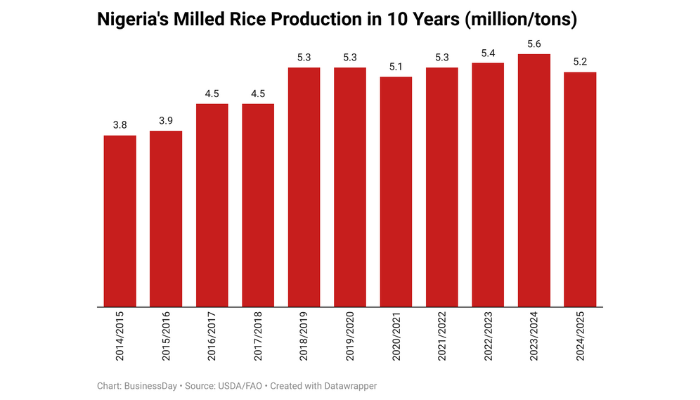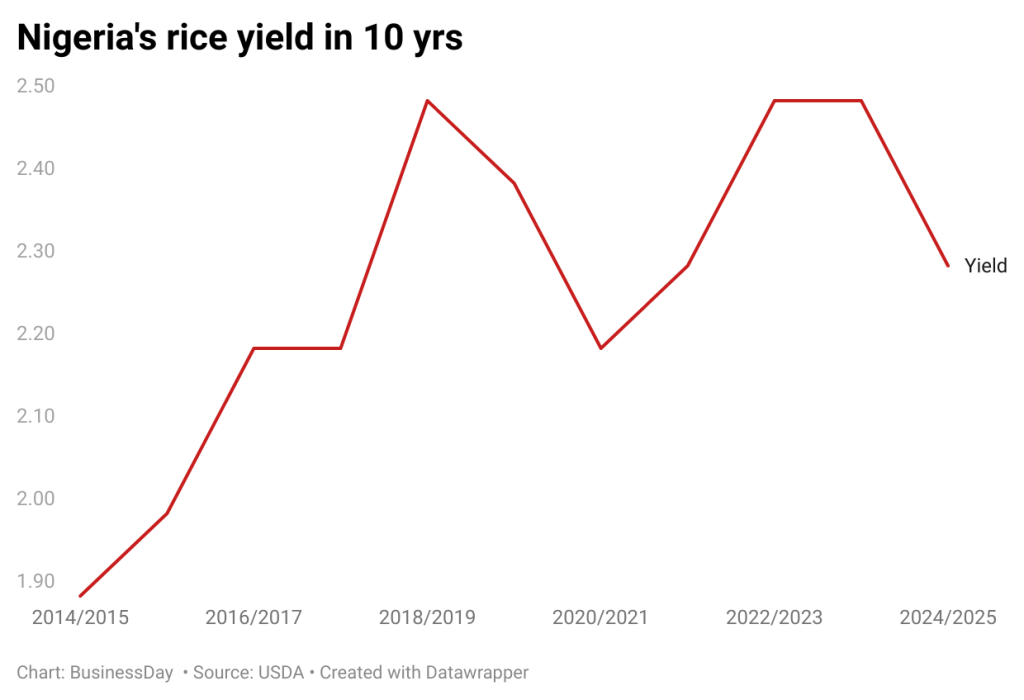Tags
Rice output hits 4-year low on high costs.
Josephine Okojie and Feyishola Jaiyesimi .

…Farmers say input prices have risen five times over the period
,,.Millers can’t get enough rice from farmers
Nigeria’s rice production has hit the lowest level in four years as high production costs force farmers to reduce their cultivation areas.
Rice production declined by 7 percent in the 2024/2025 season to 5.23 million metric tons (MT) from 5.61 million MT in 2023/2024 season, according to data from a new report by the United States Department of Agriculture (USDA). One report estimates that the decline could be between 15 and 23 percent over the period.
The USDA data indicate that the figure is the lowest the country has recorded since 2020 when the COVID-19 pandemic obstructed farming activities.
Farmers say their rice revenues and profits are hard hit by the rising input prices, with insecurity, climate change and the influx of cheaper foreign varieties making it even harder for agro-based firms to stay afloat.
“Prices on all inputs have increased four or five times already and they still keep rising,” said Muhammed Augie, former state chairman of Rice Farmer Association, Kebbi State chapter.
“Incentives to grow rice are no longer there. Demand from millers have declined, no more federal government intervention and the markets are flooded with cheaper imported rice products,” he explained.
He noted that these factors have forced several rice farmers to shift to other crops with lesser production costs, noting that those still growing rice grain have reduced their production areas.
Ahmed Idris, a rice in Jigawa, said he usually grows rice on five hectares of land but has reduced it to two hectares owing to his inability to afford inputs to cover his entire farmland.

“The money I spent cultivating five hectares two or three years ago can only cultivate two hectares,” he said, noting that the government’s subsidised inputs under the Anchor Borrowers Programme for rice farmers was huge before it was suspended indefinitely.
Anchor Borrowers Programme’s impact
Last year, the federal government suspended the Anchor Borrowers Programme – a key initiative targeted at boosting rice production. It was suspended over fraud allegations and farmers’ failure to repay loans extended to them.
While there is a dearth of reliable data on just how much progress Nigeria made during its ‘rice revolution’ under former President Muhammadu Buhari, paddy production increased from six million in 2015 when the scheme started to 8.9 million metric tons in 2023 when it was suspended, according to data from the Food and Agricultural Organisation (FAO).
The number of rice mills, both integrated and cottage, increased from 10 in 2015 when the country kick-started its rice revolution to over 100 in 2023, according to data from the Rice Processors Association of Nigeria (RIPAN).
The average crop yield per hectare of rice rose from 1.9 metric tons per hectare to an average of 2.47 metric tons of the same acreage, according to data from the UN food body. Despite the increase, the country still has one of the lowest yields per hectare among emerging markets in Africa when compared with Ethiopia’s 3.4, South Africa’s 2.9 and Kenya’s 4.2.
Millers’ plight
Millers are also hit by the shortfall in production and rising input costs as prices of paddy surged by 100 percent to between N70,000 to N80, 000 per 80kg bag, depending on location and quality.
According to RIPAN, Nigeria needs 11 million metric tons of paddy to meet the current domestic consumption. It puts production at 4.6 million MT.
The country’s rice milling industry has a processing capacity of 7.5 million metric tonnes, according to data from the association.
The association in a 2023 snapshot report said most millers had large unutilised capacity and hence huge overheads per unit of capacity utilised owing to macroeconomic challenges.
“A large number of millers have shut down operations owing to rising production costs,” Peter Dama, national chairman, Rice Millers Association of Nigeria (RIMAN), said in response to questions.
“Cost of power for running our mills has tripled. Also, prices of our paddy raw material have tripled. The logistics cost of transporting to the mills and markets has also tripled amid other rising costs,” he said.
“How do you still produce and be competitive with all of these amid high borrowing costs?” he asked, saying the challenges have made it difficult for the country’s rice to compete with imported varieties that have flooded the markets.
To address issues of millers, President Tinubu granted import-free waivers for importers of rice paddy, but the foreign exchange volatility has made it difficult for processors to import and mill at competitive prices.
https://businessday.ng/big-read/article/rice-output-hits-4-year-low-on-high-costs/Published Date: February 10, 2025






